Lameness
Lameness occurs when an animal has leg or foot pain that affects how they move. Lameness is an animal health and welfare concern, as well as a production issue. Pain due to lameness often limits growth because animals may be reluctant to eat or drink.
There are many types of lameness, with several different causes, many of which are inter-related. Lameness can be caused by genetics, environment, nutrition, injury, or infection.
On this page:
Key Points
|
Importance to the Beef Industry
Lameness in beef cattle is an animal health and welfare issue that also has production and economic consequences for cow-calf and feedlot operators. Studies show that lame feedlot cattle grow more slowly than cattle that are not lame and steers diagnosed with foot rot during the finishing period need up to two weeks longer to reach slaughter weight. A lower rate of gain can be costly in terms of welfare, labour, pen space and feed.
Many animals will recover with appropriate treatment. Chronic cases may be salvaged, provided all pharmaceutical withdrawal requirements have been met and the animal can be transported without additional suffering. Humane euthanasia on the farm is recommended when animal welfare is severely compromised and not expected to improve.
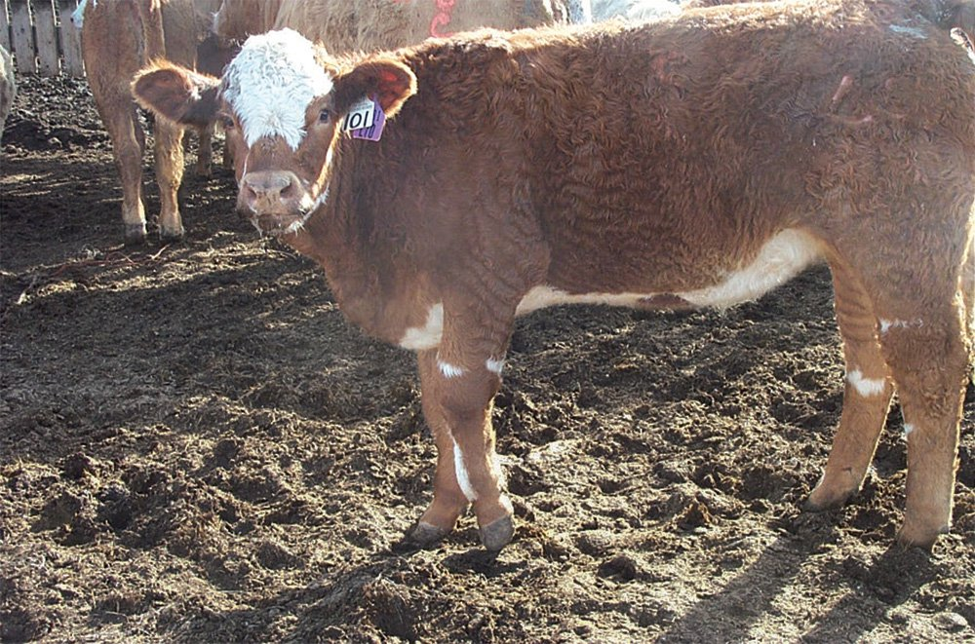
Animal showing signs of lameness (Image provided courtesy of Eugene Janzen and his team).
Incidence
A recent study analysed health records from 28 different western Canadian feedlots over a ten-year period to determine an estimate of the prevalence of common lameness conditions. The analysis demonstrated that lameness was diagnosed in 4.4% of steer and 4.7% of heifer placements. Comparing diagnoses by class of cattle, 4.9% of calves were diagnosed with lameness compared with 4.0% of yearlings.
Of the cases diagnosed with lameness, foot rot was most prevalent at 74.5%, followed by joint infections at 16.1%, then lameness with no visible swelling at 6.1%, and lameness due to physical injury at 3.1%. The estimated incidence of treatment for lameness in this western Canadian study was 32%, up considerably from the reported 16% prevalence of lameness reported in a previous American study that assessed a large dataset from five large western feedlots.
Season of placement can impact the incidence of lameness. The western Canadian study found fall- and winter-placed calves had a greater likelihood of being diagnosed with foot rot compared to yearlings. Fall-placed calves also had greater odds of being diagnosed with joint infections, injuries, and lameness without swelling, when compared to yearlings.
Lameness is more common in unhealthy cattle and is also a risk factor for developing additional diseases. In the western Canadian feedlot study, cattle diagnosed with lameness due to injury, joint infection, or lameness with no visible swelling were associated with a diagnosis of Bovine Respiratory Disease (BRD). In another study, researchers found that lameness accounted for 37.4% of cattle in the chronic illness pen, with another 10.9% of cattle being diagnosed with both respiratory disease and lameness.
Transport practices can affect lameness and may make any lameness issues worse. However, the risk is reduced when cattle are healthy and fit at the time of loading. A 2007-08 survey of 50,000 beef cattle transported in Ontario identified 79 lame cattle. A 2008 survey that looked at more than 290,866 beef cattle transported in Western Canada found 37 lame cattlehowever the study also reported that lameness was considerably more common in market cows than in fed cattle, feeders or calves. As well, the survey found that the likelihood of lameness increased with the duration of transport.
Four common causes of lameness include:
- Infection (i.e. foot rot, digital dermatitis, toe tip necrosis, infectious arthritis)
- Nutrition (i.e. laminitis, mycotoxin-related necrosis)
- Physical injury (i.e. frostbite, sprain, break)
- Genetics (i.e. bad conformation, temperament)
|
Producers should not assume that lame cattle have foot rot without close observation, to avoid unnecessary administration of antibiotics. |
Emerging causes of lameness, including digital dermatitis and toe tip necrosis, are becoming better understood, as are the multiple inter-related causes of lameness. For example, when nervous cattle (which may be attributed to genetics) scramble on hard flooring, they may damage the sole of the foot (injury), allowing bacteria to enter and colonize the foot (infection). Each of these types of lameness are associated with specific risk factors. Trauma or wet conditions that affect skin or hoof integrity can cause lameness directly and also provide an avenue for bacteria to enter and colonize a wound.
Foot Rot
Foot rot is a painful condition that causes lameness and can affect any class of cattle, whether in a feedlot, corral, or pasture. Foot rot is often characterized by a sudden onset of lameness and is worse during wet conditions. People sometimes assume any lameness is caused by foot rot however this is not true.
Foot rot is highly infectious and is caused by bacteria, most commonly Fusobacterium necrophorum. The infection originates in between the claws of the hoof and may be characterized by heat and swelling in between the claws, as well as along the coronary band where the hoof meets the skin. If it is not identified and treated promptly, the infection can move elsewhere into bones, joints, or tendons, causing delayed recovery or other complications. Fortunately, foot rot infections almost always respond well to treatment.
When breeding bulls are afflicted with foot rot, there can be negative long-term consequences for the entire herd. The increase in body temperature, stress, and pain caused by foot rot can reduce sperm production for a period of time, as well as reduce a bull’s libido, leading to open cows. Talk to your veterinarian to determine if vaccinating against foot rot infections is a useful prevention method.
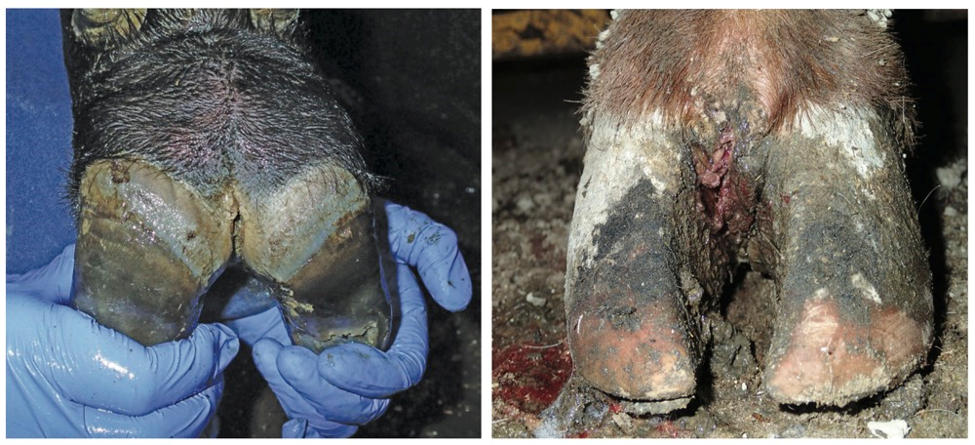
Foot rot infection demonstrating affected tissue between the claws of the hoof. (Image provided courtesy of Eugene Janzen and his team).
Toe tip necrosis is a lameness condition affecting the hind feet of feedlot cattle. It develops early in the feeding period, and often occurs within clusters of animals or cohorts. Sometimes referred to as a toe abscess or ulcer, apical white line disease, or P3 necrosis, it has been associated with improper processing or handling, abrasive flooring, as well as flighty animal behaviour. Careful, low-stress handling and proper flooring may help prevent the development of toe tip necrosis.
The symptoms of toe tip necrosis can be similar to injury, making it challenging to obtain a definitive diagnosis. It is a very painful conditionas discussed in a recent webinar (skip ahead to 41:20).
Recent research found that the disease seems to occur from the outside in. The disease starts when the white line between the sole and the hoof wall separates, allowing bacteria to penetrate into the foot reaching into the corium, which is a very sensitive tissue. Inflammation of the corium causes pain, which is made worse if the infection continues into the foot and infects the P3 (coffin) bone.
Current research is examining the impact of different treatment protocols for toe tip necrosis on different weight classes of cattle, as well as combining pain relief products. Carefully trimming the toe tips to allow the infection to drain and reduce pressure on the area is also being explored as a better way to manage the impacts of the disease.

Pressure builds as an abscess forms in the toes of a hind foot when toe tip necrosis infection is present. (Photo courtesy of Murray Jelinski).

A cross-section of the hoof demonstrates separation between the hoof wall and the white line in an animal affected by toe tip necrosis. (Photo courtesy of Murray Jelinski).
Digital Dermatitis
Digital dermatitis, also known as hairy heel wart or strawberry foot rot, is a skin infection that affects the area around the dewclaws, between the claws, and sometimes the heel of the hooves. The disease is characterized by raised lesions often located between the claws and dewclaws. These lesions are very painful, may appear red and bleed easily if disturbed, and some may have long fibrous hairs. Animals appear to walk on their tip toes to avoid putting pressure on their heels.
Digital dermatitis is highly infectious but doesn’t respond well to injectable antibiotic treatment. Once an animal is infected with Treponema, the organism primarily associated with digital dermatitis, the animal will have it for life. To complicate things, digital dermatitis may occur simultaneously with foot rot. Footbaths can be an effective treatment however there are logistical challenges when trying to use footbaths to treat large numbers of animals.
It was long thought that digital dermatitis was only a dairy cattle disease, however it is being increasingly diagnosed in confined beef cattle. A recent webinar discussed digital dermatitis in Ontario, where veterinarians are seeing the disease appear. This seems to be more common in pack barns compared to slatted barns (skip to 26:53).
Current research is investigating the use of antibiotic treatment, a footbath treatment, or a combination of both to manage digital dermatitis.An animal that has been sick over a longer period of time runs the risk of having the infection spread into bones or joints, making it very difficult to treat. For example, Mycoplasma bovis is commonly implicated in cases of pneumonia and mastitis. M. bovis can also travel through the animal’s bloodstream, sometimes settling in the ankle, stifle, hock, or elbow joints, leading to painful swelling and arthritis.
Histophilus somni is another organism that has been linked to arthritis. Unlike M bovis, there is a vaccine available for H somni.
Animals with joint infections may become chronically ill if they aren’t caught and treated in time, or if tissue damage compromises treatment. Pain management, and in severe cases, euthanasia may be required. Preventing the disease and learning to recognize these animals early on is the best strategy.
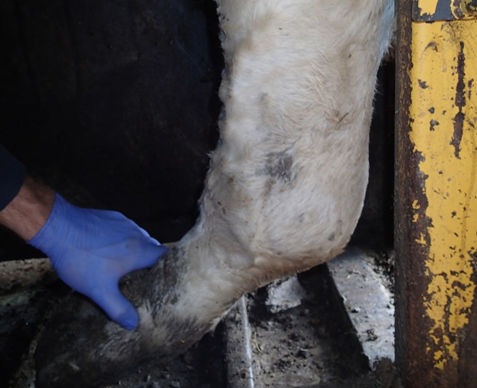
A swollen joint can cause lameness and become a serious health and welfare problem.
Laminitis is a condition where the lamellae, the layer of tissue between the hoof wall and the coffin bone, is weakened or becomes separated. Laminitis is linked to rumen acidosis which is when the rumen pH drops causing rumen bacteria to produce toxins that can pass through the rumen wall. These toxins can cause swelling in the blood vessels of the hooves, leading to founder or laminitis. Laminitis is usually attributed to diets that are high in fermentable carbohydrates such as grain, and it may occur after a sudden or rapid change in rations.
Laminitis may be more common in cattle that are held on feed too long and there is no practical treatment once an animal is afflicted, other than ensuring animals are kept on soft footing in pens that are well bedded.
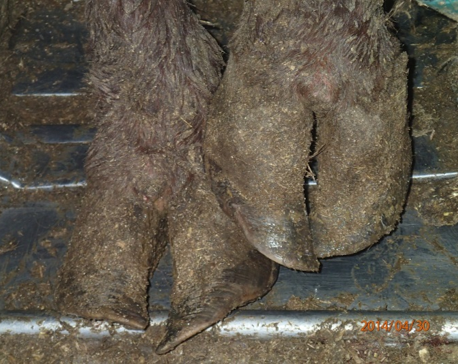
Hoof elongation and curled claws can sometimes accompany severe cases of laminitis or founder.
Mycotoxin-related Necrosis
Mycotoxins in feed caused by ergot bodies or other fungi during wet growing conditions can lead to lameness. Ergot restricts blood flow to the hooves and other extremities which can cause severe lameness and even hoof-sloughing or other debilitating health and welfare issues. These animals often become chronically ill and require pain management or euthanasia. Prevent mycotoxin-related necrosis by feed testing to avoid or dilute mycotoxin-contaminated feeds. If caught early, this condition can be reversed by removing the contaminated feed source from the ration.
Physical Injuries
Beef cattle may sustain physical injuries, including sprains, breaks, sand cracks, or frostbite. Injuries should be carefully examined to ensure the lameness isn’t caused by an infection. Treatment will depend on the extent of the injury and the course of action should be decided upon in consultation with your veterinarian.
Sand cracks, which are vertical cracks in the hoof wall, are relatively common in range cattle in the Prairie Provinces. Sand cracks typically heal themselves through thickening of the hoof wall. Environment, exposure to moisture, or heavy animals may be contributing factors to the incidence of sand cracks. Provided the animal isn’t lame, treatment is often ineffective and unnecessary. If the animal does become lame, further inspection is warranted to treat for possible abscesses or infections.
Frostbite most commonly occurs in young animals although older cattle are not immune. When tissue freezes, blood circulation to the hooves is restricted, and tissue damage – either temporary or permanent – occurs. If the animal recovers from temporary frostbite damage, they can maintain a normal life, but permanent blood vessel damage occurs at a young age and hooves will not grow properly. In these cases, quality of life and production is compromised and euthanasia should be considered.
Genetic Problems
While management and environmental conditions can cause lameness issues, poor foot and leg conformation can also be a result of genetics. Genetic causes of lameness can be passed down to offspring and are sometimes slow to appear. Producers should work with veterinarians who can score herd bulls during breeding soundness evaluations to determine if there are structural issues. Producers should also be monitoring for foot and leg conformation in replacement females. Because lameness is multi-faceted, cattle that have proper foot and leg conformation will be better suited to withstand poor pen conditions or other non-infectious risk factors for lameness.
Management, Risks & Prevention
Accurate diagnosis is important for successful treatment and prevention of lameness. Veterinarians and researchers are beginning to learn more about common types of lameness including infectious causes such as toe tip necrosis and digital dermatitis. As new information emerges, producers and feedlot staff are learning how to identify and more accurately diagnose the differences between lameness diseases. Producers should not assume that all lame cattle have foot rot without close observation, to avoid unnecessary administration of antibiotics.
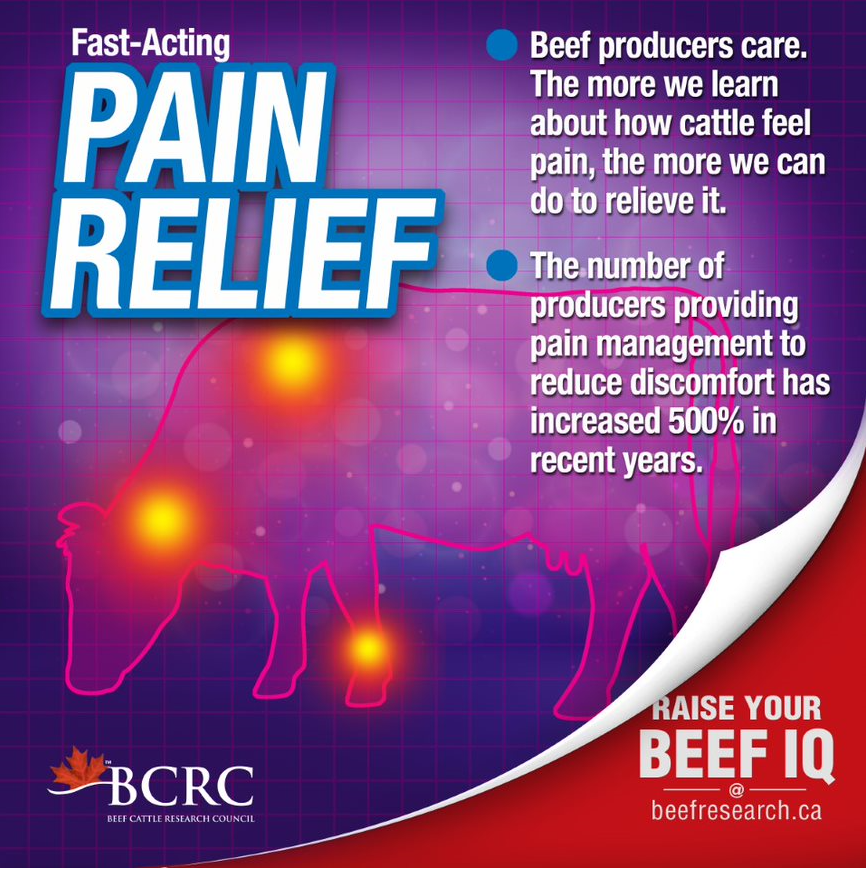
Risk Factors
There are several risk factors that work alone or in conjunction with other factors that may lead to an increased incidence of lameness.
- Poor pen environments, including excessively frozen ground, very dry environments, or extremely wet and muddy conditions may negatively affect the skin barrier, leading to foot rot and other types of lameness.
- Housing cattle in pens where Fusobacterium necrophorum-caused foot rot has been a problem in the past can increase the risk of new infections.
- Poorly designed facilities, including slick surfaces or abrasive flooring, can cause hoof damage and leg injuries.
- Sharp edges, protrusions, or objects like wire, metal, rocks, ice, and frozen manure, can contribute to physical injuries break the skin barrier, allowing pathogens to enter the hoof area.
- Research has demonstrated that fall-placed calves are more at risk for lameness and injury than winter-placed calves or yearlings.
- Improper or high-stress animal handling practices can increase risk of slipping and physical injury.
- “Flighty” or nervous cattle are more likely to damage or injure their feet and legs.
- Cattle infected with Mycoplasma bovis are at risk of joint infection.
- High grain rations, erratic feed consumption (due to weather factors or feed supply problems), and improper feed processing are risk factors for laminitis.
- Heavier cattle or cattle held on feed for too long are at a higher risk for lameness.
There are facility, health and behavioural management practices producers can employ to help reduce lameness, including:
- Regular pen cleaning and landscaping to ensure proper drainage, good footing, and to minimize build-up of manure and bacteria that causes lameness (i.e. Fusobacterium necrophorum);
- Disinfecting and maintaining hoof-trimming equipment and tools;
- Removing sharp objects, such as rocks, ice, wire or metal, that may cause injury;
- Vaccinating/preconditioning cattle to reduce disease and improve overall health and immunity in order to minimize risk of lameness as a secondary ailment;
- Practicing low-stress animal handling;
- Incorporating proper handling facility designs that include adequate traction and comfortable footing;
- Applying lime to barn floors following cleaning between fills to make the environmental pH less friendly to infectious lameness-causing bacteria;
- Consulting with your veterinarian regarding the potential use of a Fusobacterium necrophorum vaccine to prevent footrot;
- Incorporating step-up rations for high-grain diets to reduce the risk of acidosis and laminitis;
- Test feeds for potential mycotoxins that may lead to ergot poisoning;
- Carefully inspect feet and legs on breeding cattle to ensure they are fit and sound.
Learn More
Toe Tip Necrosis Syndrome (blog), Beef Cattle Research Council
Acidosis (web page), Beef Cattle Research Council
Mycotoxins (web page), Beef Cattle Research Council
Feedback
Feedback and questions on the content of this page are welcome. Please email us.
Acknowledgement
Thanks to Dr. Murray Jelinski, Western College of Veterinary Medicine at the University of Saskatchewan, for reviewing this page.This topic was last revised on March 2, 2020 at 10:03 AM.



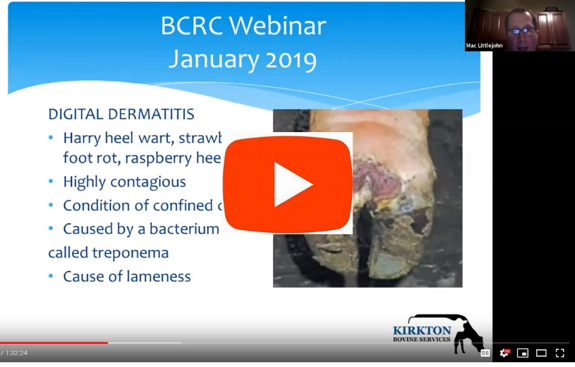
 View Web Page
View Web Page View PDF
View PDF


